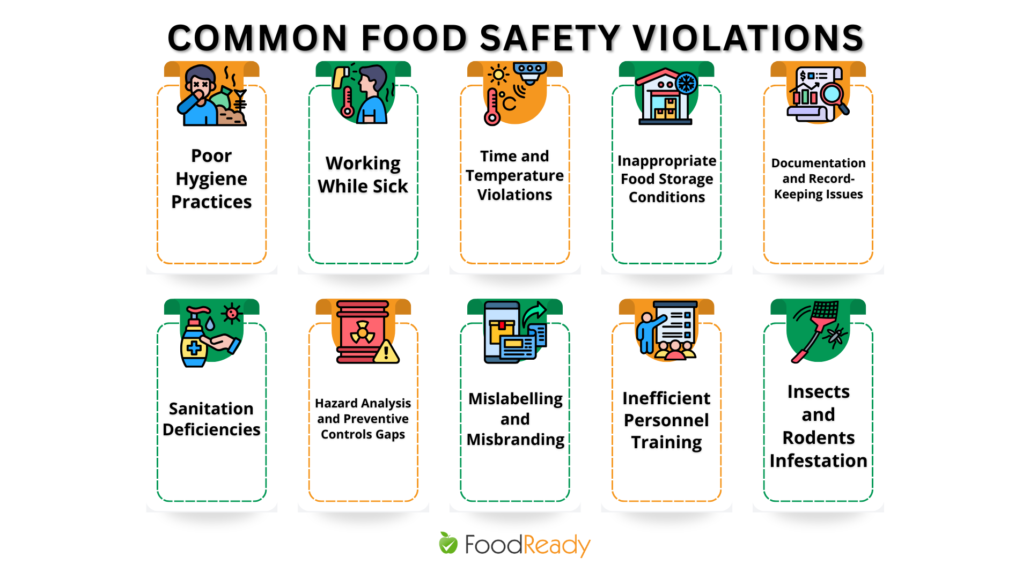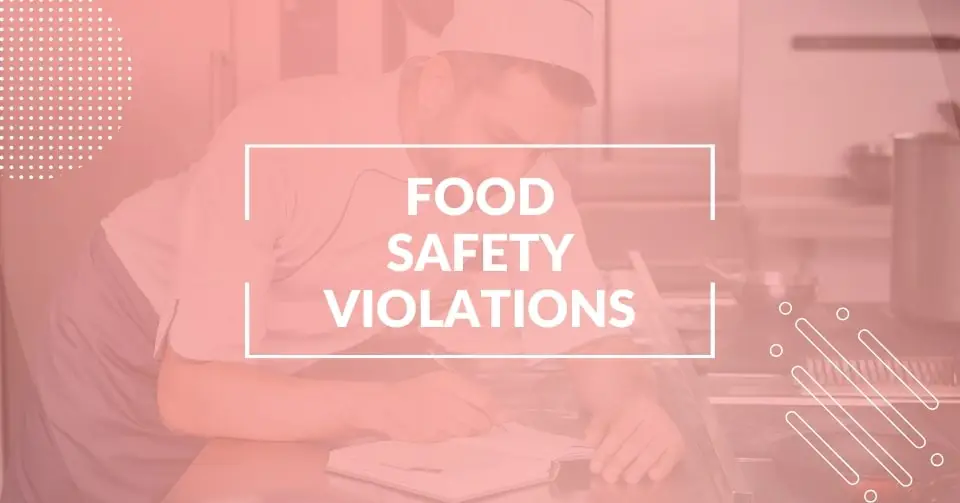Imagine your customer being hospitalized because of a preventable mistake. Ugh, it sounds terrible!
Following food safety standards isn’t just good practice but a fundamental obligation for food businesses. A single lapse can trigger devastating consequences, such as food contamination, foodborne illness outbreaks, costly recalls, severe brand damage, and even business failure.
However, despite the high stakes, the FDA and USDA consistently uncover recurring violations across the industry. But what are these pitfalls?
Understanding common mistakes is a step towards a more resilient and proactive food safety system. In this blog, I’ll tell you about the widespread food safety violations with examples and how to avoid them.
What Does Food Safety Violation Mean?
A violation occurs when a food safety standard or regulation is breached. Violations often involve not following the provisions of the FDA Food Code. These violations can happen at any point in the food supply chain, from processing and packaging to storage and service. However, they are most often uncovered during routine food safety inspections at retail food establishments.
Common Food Safety Violations Explained
Some actions and situations can be critical and cause food safety issues. Let’s look at some common foodborne illness risk factors to be aware of.
1. Poor Hygiene Practices
Poor hygiene includes many things, like improper handwashing, unsanitary conditions, etc.
CDC conducted research and observed food workers for safe food handling. They noticed that workers washed their hands about 2 or 3 times in an hour when they should have done it about 9 times after each activity requiring handwashing.
Moreover, only 25% of workers washed their hands after handling raw animal products or dirty equipment, and only 1 out of 10 workers washed their hands after touching their face or body.
2. Working While Sick
That’s a critical violation that can compromise food safety, as ill workers can transmit foodborne pathogens while working with food. Prevention and disease control measures are essential to stop sick workers from causing foodborne illness and to protect public health. So, whatever hard-working workers you have, they should stay home when they feel unwell or at least avoid food in some cases.
3. Time and Temperature Violations
We often highlight the importance of keeping food out of the Temperature Danger Zone (TDZ), which is 41°F and 135°F (5°C and 57°C). Otherwise, harmful bacteria can grow and contaminate food, leading to contaminated dishes that pose serious health risks.
Food also becomes unsafe to eat if it’s left out for longer than four hours. We’ve covered this in more detail in our blog about TCS foods.
4. Inappropriate Food Storage Conditions
Another violation is inadequate food storage, which is frequently cited in retail establishments. This can include wrong temperatures or failing to separate raw and cooked foods. The last one can cause cross-contamination, which means the transfer of harmful pathogens from food or surfaces to food.
5. Documentation and Record-Keeping Issues
FSMA 204 perfectly demonstrates the importance of proper recordkeeping. Poor documentation can reduce the effectiveness of recalls, complicate investigations, and lead to regulatory non-compliance.
Violation examples include missing or incomplete SOPs, failure to maintain records related to batch production, monitoring logs, food sanitation, training, etc. The elimination of sanitation risks is crucial, and it is important to avoid redundant processes in cleaning procedures to ensure efficiency and consistency. Other issues include inaccuracies, alterations, and not documenting deviations and corrective actions.
6. Sanitation Deficiencies
Sanitation issues remain a persistent headache as they are one of the leading causes of food safety violations. They can include unclean equipment or facilities, inadequate cleaning and sanitizing, poor pest control, conditions causing cross-contamination risks, etc.
7. Hazard Analysis and Preventive Controls Gaps
What can go wrong with HACCP? Issues can include incomplete analyses that miss foreseeable biological, chemical, or physical food safety hazards, failure to establish necessary preventive controls, lack of scientific validation for controls, and inadequate monitoring, corrective actions, or verification procedures.
8. Mislabelling and Misbranding
The information on the label must be correct. Related issues include undeclared allergens, incorrect ingredient lists, inaccurate weight statements, or even non-compliant claims, such as “vegan” when the product is not vegan. Proper labelling is especially important in schools and similar institutions, where food safety violations can lead to serious health risks and are subject to regular inspections.
9. Inefficient Personnel Training
Your team is your first line of defense; inconsistent training and lack of food safety awareness can create vulnerabilities.
What are the common issues? Poor training on GMPs, specific job functions, or food safety principles can result in poor hygiene and failure to follow established procedures.
10. Insects and Rodents Infestation
Infestation is a serious concern because insects and rodents can cause food contamination and foodborne illnesses.
An illustrative case occurred recently in the UK when Rude Health Foods Ltd recalled Rude Health Chocolate Crunch Granola due to the possible presence of insects.

Understanding Root Causes of Food Safety Violations
There’s a root cause hiding behind each food safety violation. Addressing these root causes is essential for effective food protection, as it helps ensure regulatory compliance and safeguards public health. It’s not only about breaking the rules; it’s about deeper reasons. Understanding them can help you stop violating the rules or prevent it from happening.
1. Poor Food Safety Culture
Sometimes, a workplace treats food safety as a secondary issue while prioritizing speed or convenience. At this facility, supervisors and managers may fail to model safe practices, while employees can fear reporting issues or making mistakes.
No consistent enforcement of food safety rules is a huge mistake in today’s industry.
2. Time Pressure and High Workload
Sometimes, it’s all about lack of time and high intensity. Suppose employees rush to deliver the product, whether a meal at a restaurant or a huge batch of chicken salad at a manufacturing plant.
In that case, they can simply wash their hands less or not notice some essential details in the documentation. Pressure and a lot of work trigger the human factor.
3. Lack of Knowledge and Continuous Education
Lack of food safety training is an issue itself, but it’s also why other food safety violations occur. Hopefully, many companies consider training non-negotiable, not only because of regulations.
4. Lack of Resources or Investment
A limited budget can lead to cutting costs and resources or failing to maintain appropriate conditions. Workers can fail to comply with food safety regulations if there are few or broken handwashing stations, insufficient cleaning supplies, or outdated equipment.
A low budget can also mean less dedicated staff, so current workers are overloaded.
5. Ineffective or Overcomplicated Procedures
Sometimes, processes may not be efficient enough. Make sure your company rules aren’t confusing, impractical, or poorly implemented. Issues can also include too complex SOPs, a too generic food safety plan, or a cumbersome digital system.
6. Poor Supervision and Accountability
Lack of clear oversight can influence compliance. For example, suppose there are no consequences for repeated violations.
In that case, supervisors don’t check for adherence, and no one is responsible for ensuring tasks are done correctly, which can lead to negative consequences.
7. Normalizing Food Safety Risks
Sometimes, it’s all about how you treat a problem and your habits. “Everyone does it,” “Nothing bad has happened,” these are the dangerous signs.
8. Organizational Misalignment
A violation can happen when leadership priorities don’t match compliance goals. For example, business owners may prioritize profits over safety, or the departments may not communicate clearly.
9. Communication Gaps
Communication is key, right? Problems like unclearly or inconsistently communicated food safety instructions, a lack of translated material for multilingual teams, or disconnected management and operational staff can cause disruptions that, in turn, cause violations.
10. No Centralized Digital System
It’s easy to miss the blind spots when businesses still handle their operations with numerous platforms, apps, files, etc. Managers can simply oversee some concerning issues in a pile of documents or tabs.
Food Safety Violations Are Scary — But You Can Prevent Them
Taking preventive measures is a great strategy. How can you avoid or minimize food safety concerns in a food facility?
- Invest in Comprehensive Food Safety Training. Food safety training is a cornerstone of adequate food safety practices without violations.
For example, let’s take restaurants. CDC found that food safety training for CKMs (Certified Kitchen Managers) positively impacts restaurant inspection results. Establishments with trained managers are less likely to violate food safety norms.
- Ensure Proper Hygiene Protocols. The same CDC observed the aspects contributing to more frequent handwashing: more free time, food safety training, and sink accessibility.
- Implement Strict Sick Leave Policies. If your workers feel sick, exclude or restrict them until they get better.
The FDA Food Code strictly indicates that people in charge must exclude or restrict food employees from a food establishment if they have symptoms like diarrhea, vomiting, jaundice, or sore throat with fever or are diagnosed with hepatitis A, typhoid fever, norovirus, or other illnesses.
- Maintain Strict Time and Temperature Control. Pay attention to storing food. Monitor and control the temperature to ensure that the equipment is working correctly. Maintenance management is critical here.
- Practice Proper Food Storage and Labeling. Use the FIFO method. Ensure all foods, especially TCS foods and allergens, are correctly labeled, stored at appropriate temperatures, and separated to prevent cross-contamination.
- Conduct Regular Internal Audits. Self-inspections help identify gaps, promote accountability, and catch minor issues before they escalate into serious violations.
- Optimize Sanitation and Pest Control. Review and simplify cleaning and sanitizing procedures. Implement a proactive pest control program.
- Ensure Qualified Management and Oversight to control the processes, handle incidents properly, and avoid bad working habits or ignoring repetitive issues.
- Perform Root Cause Analysis. If a violation has already occurred, analyze and address the root cause. In one of our blogs, we described how root cause analysis and CAPA improve food manufacturing.
- Implement Food Safety Software. To centralize and optimize your efforts, you should implement a digital solution to get a better overview of your operations, track progress, communicate clearly, and do other crucial things.
Sounds Overwhelming? FoodReady Is Here To Help!
At FoodReady, we know how difficult it can be to keep up with all the food regulations, requirements, and industry standards. Every day, we help our clients stay compliant and audit-ready while also boosting productivity and profitability.
FoodReady food safety software supports safety inventory, compliance, audit preparation, traceability, documentation, finance, and many other daily aspects of the food industry.
The platform is an excellent tool for coping with the triggers of food safety violations: it offers comprehensive inventory management, risk assessment tools, a HACCP plan builder, a digital document management system, checklists, notifications, reports, analytics, and more.
This tool will help you communicate clearly with your team and across departments, structure and efficiently manage your SOPs and food safety plans, and get rid of cumbersome paper records or numerous spreadsheets.
Our food safety consultants can also help you find the gaps, prepare documentation, and get ready for food safety audits, including GFSI, BRC, SQF, FDA, etc.
The software automates many routine tasks that should already be automated. This means that while the software performs repetitive tasks, workers can concentrate on more essential duties requiring human input.
We prioritize food safety; if you are looking for a solution like this, we are here to help. Just like it was with Eurobake, the company’s owner, Josh Svenhard, struggled to find a solution that puts food safety first.
The company wanted a solution to help them pass a third-party audit and expected to do it in 18 months with a QA manager. After matching with FoodReady, Eurobake passed the Costco audit in just 5 months! That’s thirteen months of saved time!
Book a demo with FoodReady today to learn how our software and expert support can help you make and sell safe and quality food.
Stay ahead of violations and protect your customers.
Use FoodReady to streamline compliance, automate food safety tasks, and keep your entire operation audit-ready every day.
Conclusion
Food safety violations can vary, from insufficient training and inconsistent documentation to neglecting vital rules like handwashing and keeping food out of TDZ.
You can avoid food safety breaches by understanding and dealing with their root causes, ensuring proper training, consistent and easy-to-follow workflows, enough handwashing places, etc.
Implementing a food safety application is also a great way to streamline food safety processes and reduce risks.
FoodReady can become your main tool for handling food safety, documentation, recalls, communication, etc. We care about food safety, which makes it a perfect match for food companies. Book a demo to improve your food safety today!
FAQs
Food safety violations can lead to food recalls, penalties, legal issues, loss of customer trust, and even business closure.
Food safety software can be your number one helper as it automates many processes, reduces human errors, and gives you better oversight of your business.
Vital food safety compliance records include the HACCP plan, SOPs, CAPA, food safety plan, supplier records, recall plans, and traceability logs.
You must implement corrective actions. It can be withdrawing the product from the market, retraining employees, sanitizing the food preparation surfaces, equipment maintenance, etc.
A widespread food safety risk is poor personal hygiene among workers.








